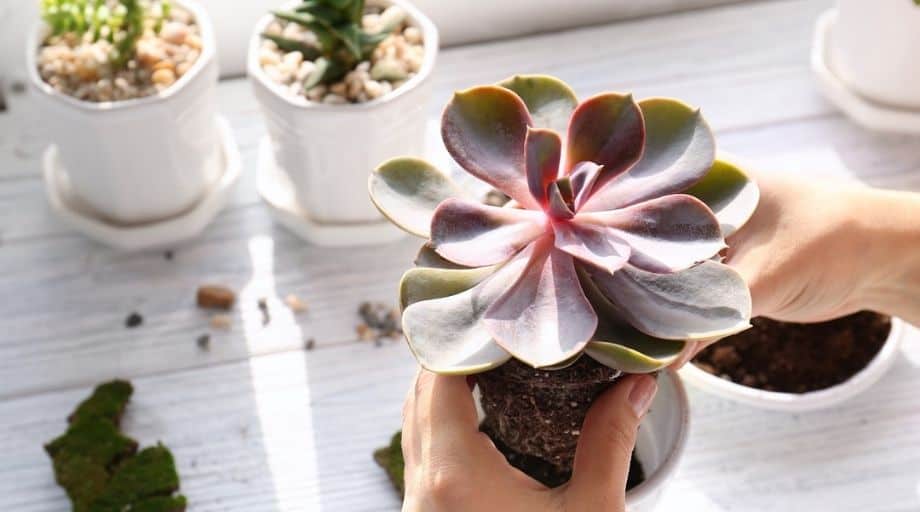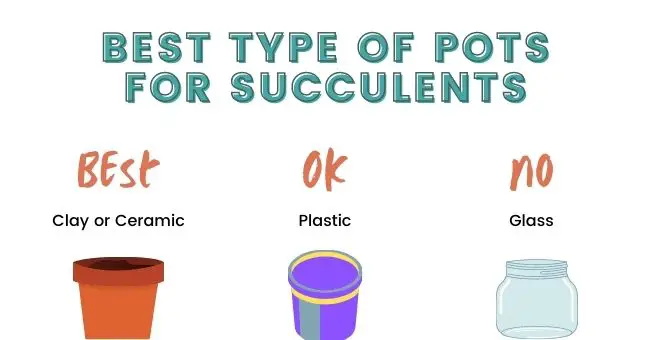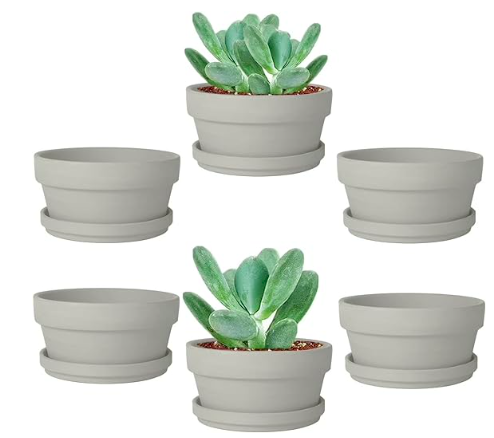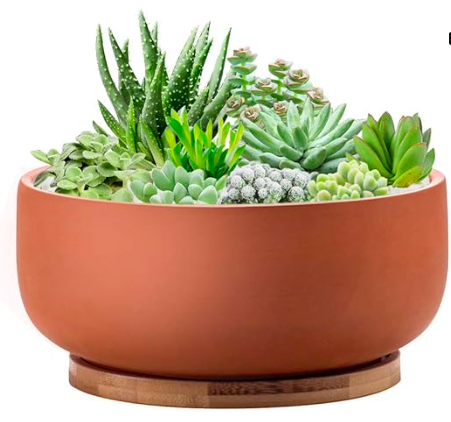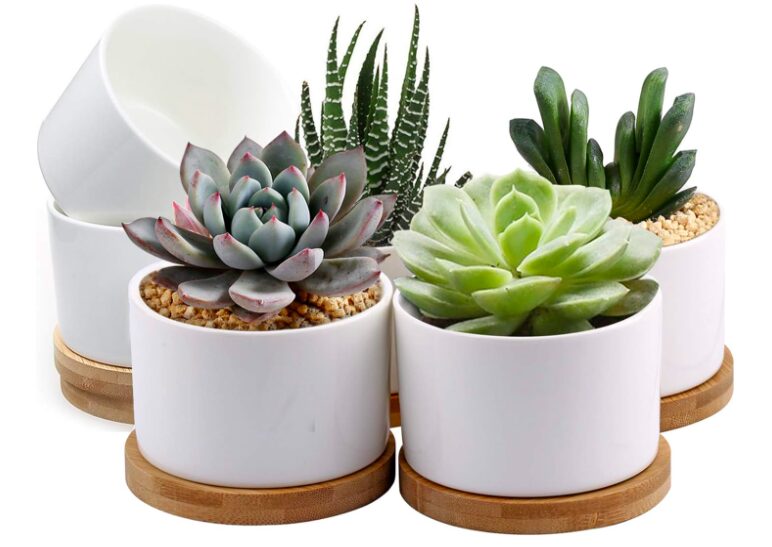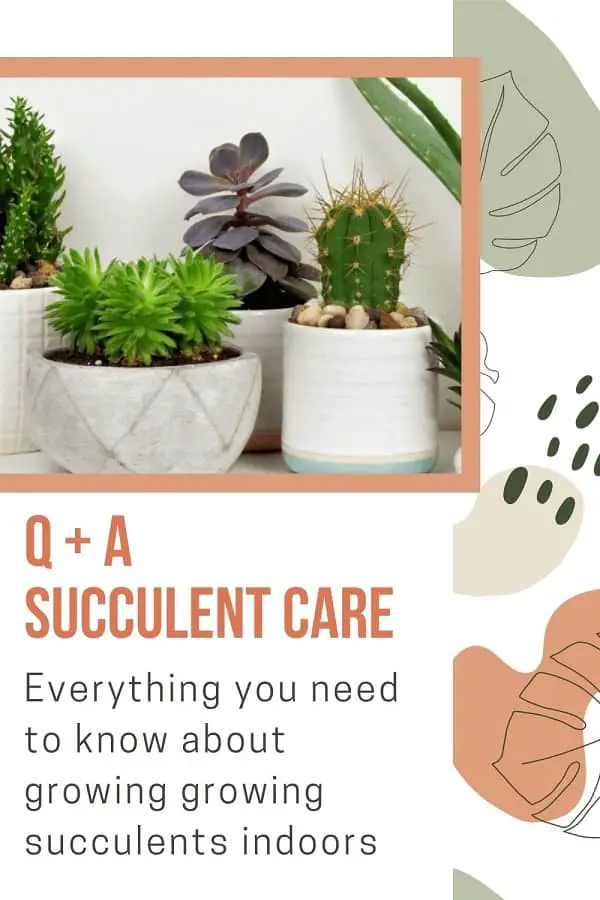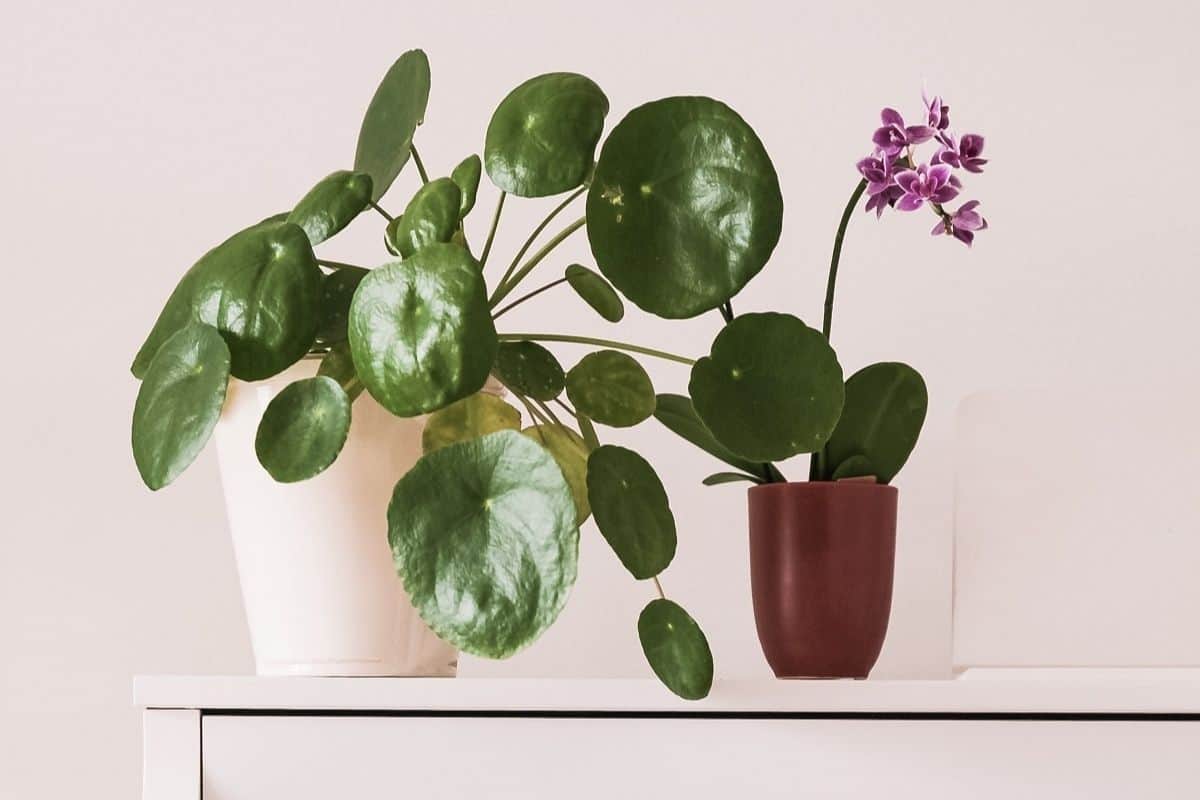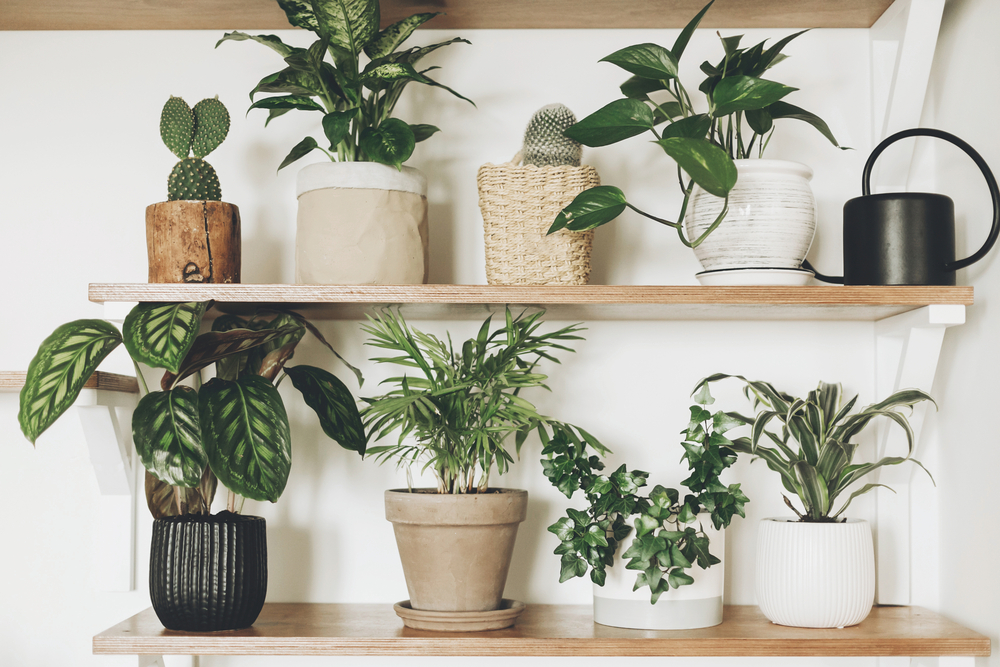Last Updated on June 22, 2024 by Plantiful Interiors
How to grow succulents indoors? 5 Popular questions answered
Although succulents’ natural environment is outdoors, they adapt very well to indoor conditions making growing succulents indoors quite easy.
Succulents, along with tropical houseplants, have become a popular home decor trend.
The visual appeal that plants add to any room has been highlighted across social media which has played a major role in riving $52.3 billion dollars in lawn and garden retail sales in 2019.
This post contains affiliate links. As an affiliate partner of various brands, we earn a little commission on qualifying purchases, at no extra cost to you. When you purchase through our links, you help our business to keep going. So thank you for your support! You may read our full disclaimer for more information.
If you want to add succulents to your home decor, you’re going to need to learn how to grow succulents indoors to keep them alive and healthy.
We’ve written this article to help you learn how to grow succulents indoors and provide you with some common succulent care tips.
If you’re already in the midst of trying to grow succulents but they aren’t doing as well as you’d hoped, you’ll find some excellent succulent growing tips to help with your succulent care routine.
Growing succulents really can be easy, once you know what you’re doing.
Let’s dive in!
5 Most Common Questions people have on How to Grow Succulents indoors:
- Are succulents easy to grow?
- How much sunlight do indoor succulents need?
- How often do succulents need to be watered?
- What type of soil do succulents need?
- What type of pot should I plant my succulent in?
All of which will be answered in this article.
1. Are Succulents Easy To Grow?
Yes! Succulents are very easy to grow indoors when cared for properly.
Succulents don’t require a lot of effort, but you do need to know what the proper way to care for your particular succulent is.
Later in this article, we’ll give you some general water and sunlight guidelines.
But it’s always a good idea to look up the specific care instructions for the succulent you own.
Not all succulents are the same and some are going to do better indoors than others.
However, succulents are easy to grow plants that take minimal effort.
These indoor plants are special because they quickly adapt to the environment in your home.
Succulent plants are great at surviving in dry conditions (this is good news for those who forget to water their plants).
They are easy to grow indoors and do not require a lot of humidity.
Here’s a great video highlighting the top 7 indoor succulents for beginners.
2. How Much Sunlight Do Succulents Need To Grow Indoors?
Succulents love sunlight!
Sunlight is a significant requirement for the survival of your succulents.
For optimal growth, place your succulents near direct sunlight (particularly an East facing window) where they will get 6-8 hours of sunlight per day.
If your succulents are not getting the ideal amount of light, they will most likely end up dying or stretching beyond repair.
Now, with this being said, newly planted succulents should be gradually introduced to direct sunlight so they don’t get scorched.
Place them in an area that has indirect sunlight and gradually move them towards direct sunlight over a 2-3 week period.
You’ll want to keep an eye on your succulents during extremely hot summer days.
If you notice your soil drying out quicker than usual and/or the leaves are starting to show burn marks, move your succulent out of the direct sunlight to an area where it will still get good sun exposure.
If your succulent is leaning this is likely because it is reaching for sunlight.
Especially if it is in a space that gets indirect sunlight.
To prevent your succulents from leaning, rotate your succulents every couple of weeks, or as you notice them leaning.
During the winter months, you may need to provide your succulents with extra light using artificial light.
This will help keep your plants healthy and happy when the days are shorter and the sunlight isn’t as plentiful.
Related Reading: Best Succulents For Your Office
3. How Often Should You Water Succulents?
Wondering how often should you water succulents is a very common question amongst new succulent owners.
We suggest watering your succulents every 5-7 days.
Although some may require water less frequently during certain times of the year which you’ll learn about later in this article.
Succulents don’t require daily watering.
If you are watering them every day, you run the risk of overwatering and drowning these adorable little plants.
By monitoring your succulents regularly, you’ll be able to tell if they need water.
Some signs that your succulents need watering are:
If your succulents are showing any of these signs, you know it’s time to water.
We find these small moisture meters really handy for helping us know when to water our succulents, without having to dig our finger into the soil and they take the guesswork out.
Your succulents should be planted in a container with drain holes.
Place a saucer or drip tray beneath your pot as you’re watering to catch the excess water that drains out through the drain holes.
Be sure to wipe up any excess water immediately.
You don’t want stale water gathering in the drip tray.
You also don’t want your pot sitting in excess water where the roots will continue to try to soak it up and risk overwatering.
If the soil around your plant is bone dry you’re going to really need to soak it.
Pour some water into your pot then watch how quickly it soaks in.
Continue to add more water just until the water stops getting soaked up and begins pouring out the bottom.
This will help ensure that the soil all the way at the bottom gets a good soak.
When watering your succulents, aim the water directly at the soil.
If you get water on the succulent leaves wipe them off with a dry cloth.
If you leave the water on the leaves you risk the sun drying up the water and burning the leaves.
Succulents are like cacti, they survive in dry and hot climates and absorb moisture from the air around them.
If you water your succulent (or cacti for that matter) every day they will not survive.
Although most succulents have a dormancy period, you will likely not notice this when growing succulents indoors.
As long as you provide the necessary water and sunlight your succulents need, you will continue to see growth year-round in most succulents.
That being said, during the winter months, you may notice Agave, Echeveria and Euphorbia will slow in growth during this period which means you should cut back on how often you water them.
You probably won’t see much slowdown in other succulents provided the nutrients are being met regularly.
Another way to know if your succulent needs water is based on the leaves.
If the new leaves are drying out and falling off that’s a sign that your succulent needs watered.
However, if the older leaves that are close to the bottom of the plant (near the soil) are drying out, there is nothing to worry about.
That is the natural life cycle.
4. What Type Of Soil Do Succulents Need?
Succulents require a fast-draining soil that doesn’t compact.
The soil must have good aeration and remain lightweight.
One of the most common reasons people struggle to grow healthy succulents is due to the soil they are using.
It’s often too dense and retains too much water, which leads to plants being overwatered which leads to death.
Look for a potting mix that contains grit (pumice or perlite) as this is what will provide the aeration your succulents need without holding the water and compacting the mix.
Although you want a gritty mixture, do not use sand.
Sand will make your potting soil heavy and dense and does not provide sufficient drainage.
If you’re not satisfied with the grit of pumice add some orchid bark or black lava rock.
Each of these will act as porous ingredients to help keep your soil aerated and fast draining.
The soil must be able to drain easily, otherwise your succulents are at risk of root rot.
We prefer mixing our own potting soil for our indoor succulents.
This gives us more control over what is used and the quantity of each ingredient.
DIY Succulent Potting Mix
The best potting mix for succulents that we’ve found so far is a DIY mix.
Our favorite homemade succulent potting mix uses:
3 parts compost – an excellent source of nutrients
2 parts coco coir – helps retain water and nutrients while keeping the mixture lightweight
1 part pumice – helps eliminate clumping and compacting, keeps the soil aerated and fast draining
If you’re using the Burpee Organic Premium Potting Soil, we recommend only mixing 1 part coco coir as the potting mix already has some in it.
Combine all ingredients together in a large mixing container, using your hands to stir it it.
Make sure the mixture is well mixed.
Squeeze a handful of this DIY succulent mix together.
If it keeps its shape add more pumice to create a grittier mix, but if it’s falling apart this is the mixture you want.
If making your own potting mix isn’t really your thing, check out this pre-mixed succulent and cactus soil that contains a similar mixture to the recipe above.
The reason we like to mix our own is so that we can adjust the quantities if needed.
5. What Type Of Pot Should I Plant My Succulent In?
Size matters!
Whenever you are planting succulents indoors, you need to find a container that is perfect for it.
Plant your succulent in a container that is two inches bigger than the succulent plant itself.
As your succulent grows, you may need to transfer it into a larger pot.
Related: How to Repot a Plant in 7 Easy Steps
Thankfully, succulents don’t tend to grow into huge plants so you shouldn’t have to worry about transplanting often.
The most important piece of advice when choosing the right pot for your succulent is to make sure that the pot you choose has drainage holes.
This will help prevent water from being held in the soil, allowing excess water to drain quickly.
Best: Terracotta, Clay or Ceramic Pots
Clay and ceramic are both popular choices for most succulent pots because of their porous material.
These types of pots will help soak up any extra moisture from the soil and create a better exchange of oxygen.
And, as you know by now – good airflow and drainage are key to growing healthy succulents.
Clay or ceramic pots work well for succulents that are going to be planted individually or up to groups of three.
Anything above this could cause the pot to be too heavy.
If planting a group of two or three succulents, make sure to leave some space between each to allow for growth outward and upward.
If you’re not a fan of the boring terracotta-colored pots, you can easily spruce them up with a little bit of paint or rope, or tuck them inside a more decorative pot.
For some inspiration, check out this simple DIY painted plant pot tutorial
Good: Plastic Pots
Now, if you’re someone who easily forgets to water their plants, you may want to opt for a plastic pot with drain holes for your succulents such as a grower’s pot.
Plastic pots tend to hold water for a longer period of time compared to clay.
Plastic pots are also an excellent choice if you have pets in your home as they are less likely to break if your cat decides to knock your succulent over.
Not Advised: Glass Pots
Although mason jars are super cute and great for many diy home decor projects, we don’t recommend planting your succulents in glass containers.
They just aren’t breathable enough and your succulents need good air flow.
Here are a few of our favorite succulent pots for indoors:
Recap: Our Best Advice On How To Grow Succulents Indoors
- Place your succulent in an area where it can receive 6-8 hours of direct sunlight.
- If you notice your succulent leaning to one side, rotate it every couple of weeks.
- Water your succulent every 5-7 days based on the moisture content of the soil. You want the soil to be dry before adding more water.
- When watering, make sure the water is draining out the bottom. Wipe up any water that gets on the leaves and don’t leave water sitting in the drip tray or saucer.
- Use a potting mix that contains grit and lightweight material to allow for fast draining and good aeration.
- Choose a container that has drainage holes and is 1-2 inches larger than your succulent.
Enjoyed How to Grow Succulents Indoors? Related reading:
How To Make A Succulent Wreath
10 Best Succulents For Your Office
50+ Cute & Funny Plant Sayings For Your Next DIY Pot Project

